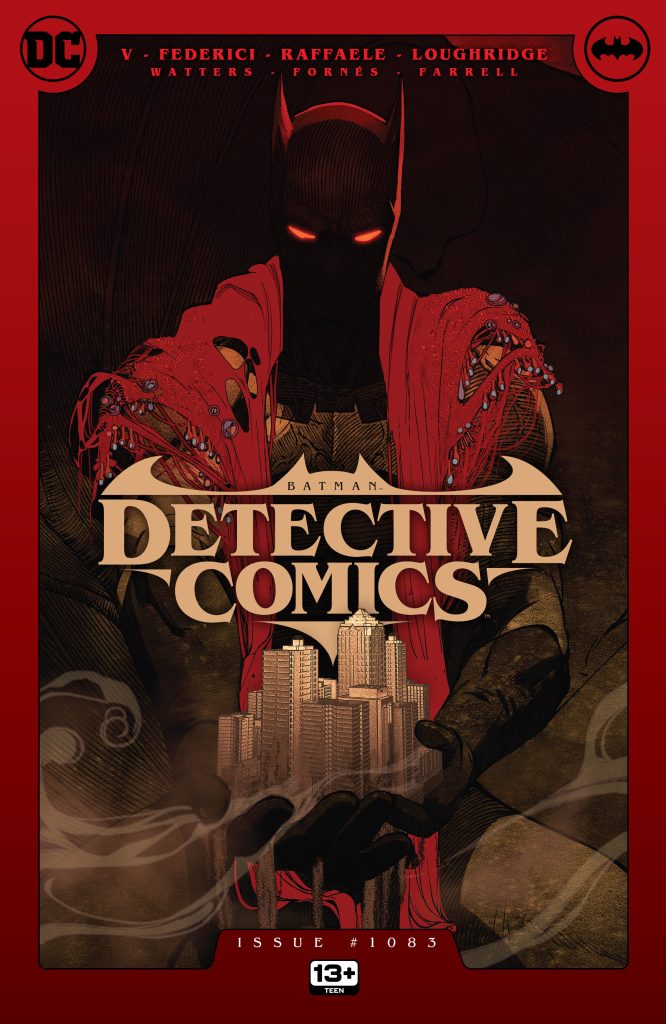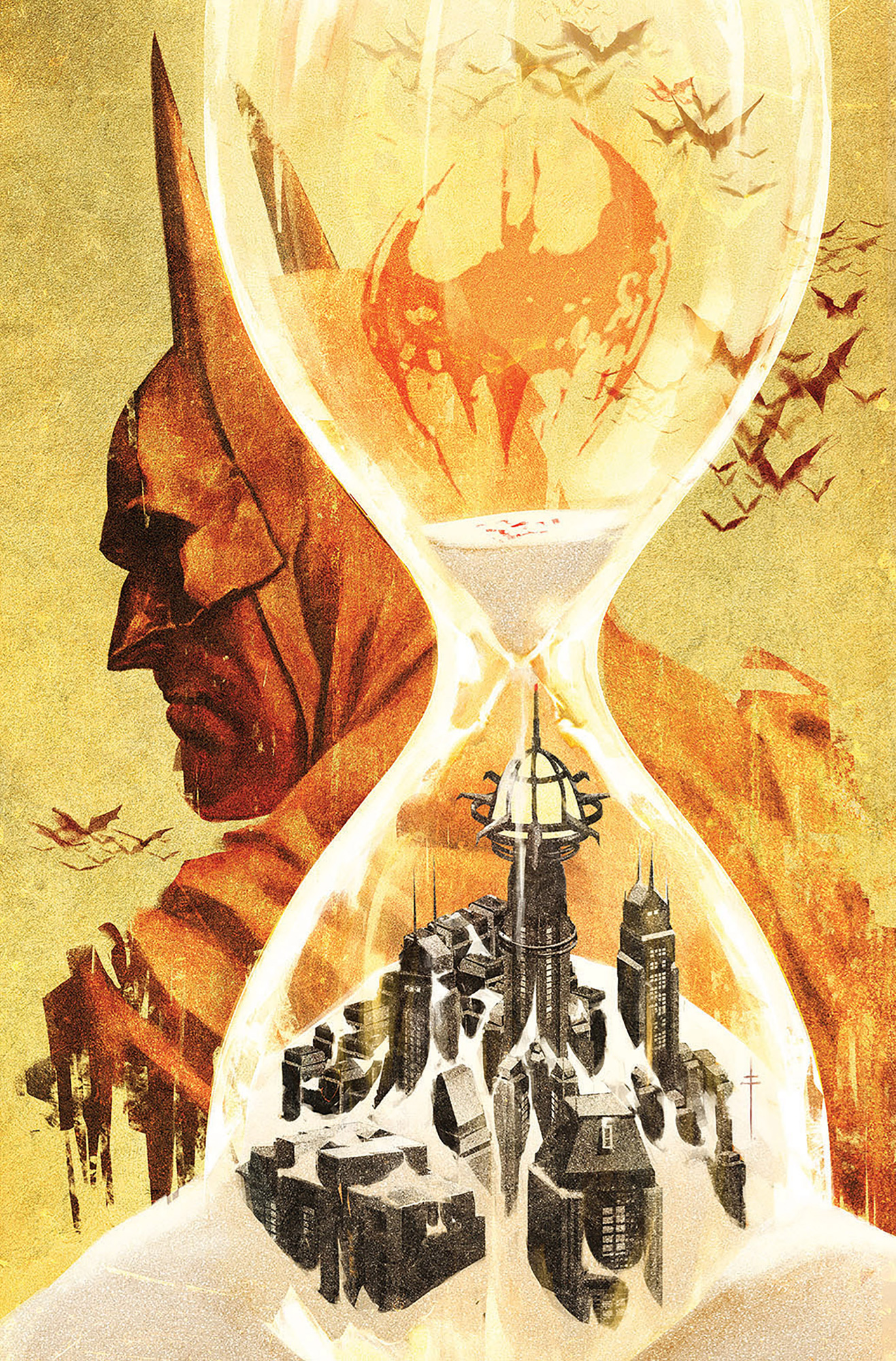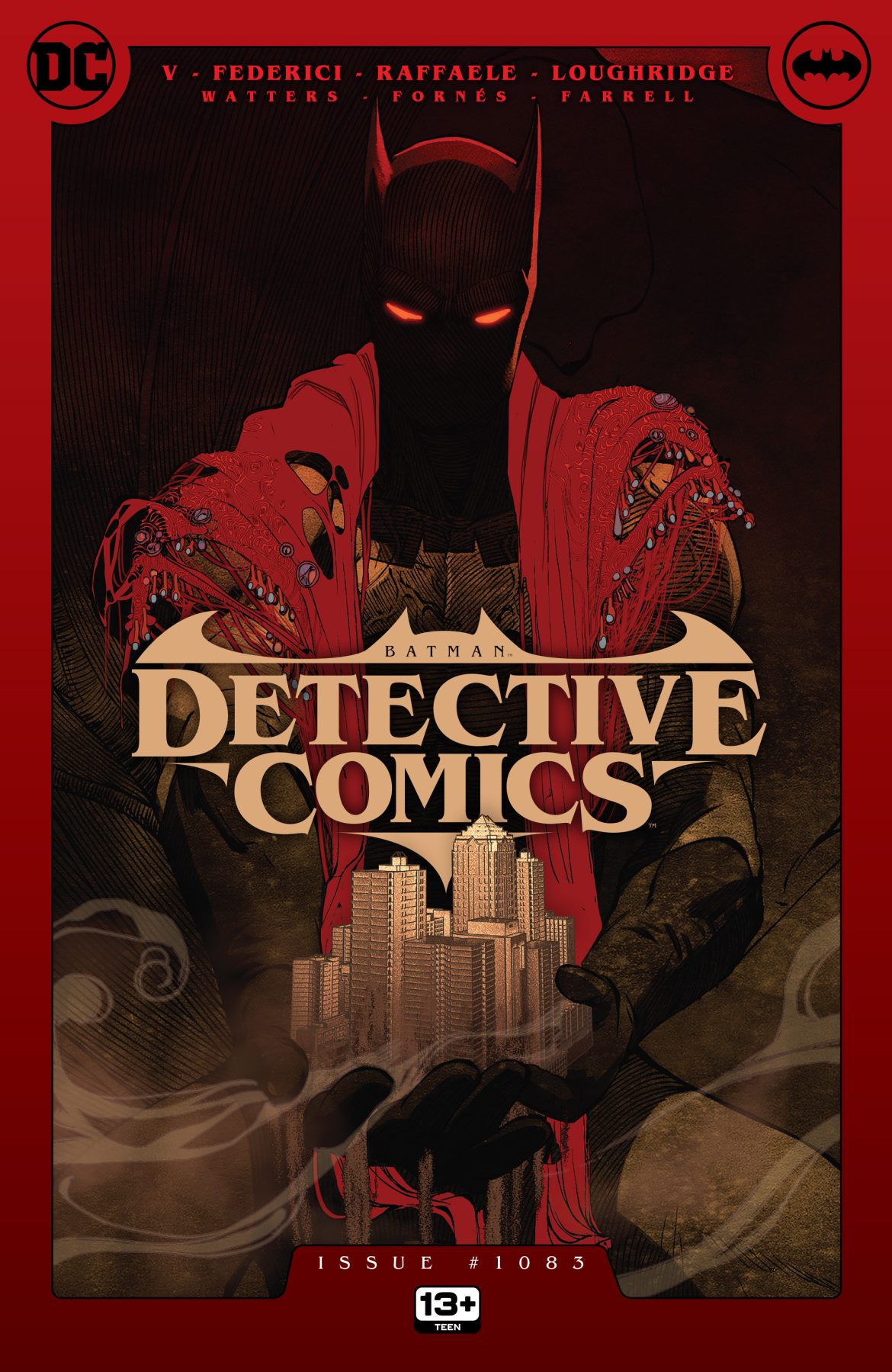In this review of Detective Comics #1083, Batman and The Question conclude “An Elegy of Sand” as Dr. Hurt’s victims collapse into madness.
Title: Gotham Nocturne: Act III: An Elegy of Sand, Part III and The Question in: Gotham, Forget Me Not, part 3
Writer: Ram V
Artist: Riccardo Federici and Stefano Raffaele
Colors: Lee Loughridge
Main Cover: Evan Cagle
Variant Covers: Riccardo Federici, Kelley Jones, Sebastian Fiumara
Release Date: March 26, 2024
 Detective Comics #1083 begins as three young men drag a stabbed and bleeding Batman to shelter from a tyrannical version of himself. He tells them to run and resist, then blows himself up to destroy the evil Batman. Dr. Hurt approaches, scolding Batman for childish attempts at righteousness. As the azmer demon approaches, Hurt says he will return with his final offer.
Detective Comics #1083 begins as three young men drag a stabbed and bleeding Batman to shelter from a tyrannical version of himself. He tells them to run and resist, then blows himself up to destroy the evil Batman. Dr. Hurt approaches, scolding Batman for childish attempts at righteousness. As the azmer demon approaches, Hurt says he will return with his final offer.
Renee Montoya stalks the streets as the Question, while Mayor Nakano tries to make the trains run on time while collaborating with the Orgham mouthpiece Shavod. Renee tries to connect Shavod to Detective Fielding’s death so she can fight the Orghams.
As Batman beats the azmer one more time, Barbatos approaches under a cherry tree in pink blossom. He offers Bruce the chance to win – and Bruce rejects him, saying Batman falls and stands back up again. He doesn’t have to win. Barbatos leaves, promising regret. Hurt screams as Bruce rejects becoming a demon, but Bruce punches him away.
Talia fights Flamingo, and Bruce arrives and punches out the pink cannibal.
Renee gives Jim Gordon her evidence against Shavod, telling him to use it to get the people to rebel against the Orghams. The Orgham soldiers attack, but so does an army of bats, followed by Batman.

Analysis
“An Elegy of Sand” and “Forget Me Not” conclude by combining, but like so much of the rest of this arc, Ram V has embraced the fantasy and metafictional exploration so much that the sense that “anything can happen” and therefore there are no rules and consequences for what does happen. How is the azmer demon defeated? How does a punch defeat Barbatos? Is Dr. Hurt really present in some way? None of these questions are answered, and Batman magically appears in Gotham at just the right time. How would Jim actually use the evidence Renee has collected? Why does Renee keep releasing the gas that bonds her mask to her face without the mask coming on and off? Why does Jim have connections that Renee, the actual current Commissioner, doesn’t? The real answer to all of these questions is “vibes” or “emotional impact”, but without any kind of coherent in universe framework of rules which make the character actions make sense, the vibes fall apart on the slightest inspection. Like the smoke Renee is releasing, instead of being functional (taking off her Question mask), it’s just atmosphere, to be blown away in a puff of breeze and forgotten the next day.
Ram V seems to intend this issue to serve as the philosophical and metafictional climax of his run – Batman dies and is reborn with a “new” purpose or reason to fight. But what is that purpose? To resist evil? To stand again after he falls? Not to win, but to keep fighting? All of this is good – but it’s good for Batman because Denny O’Neil and so many others have done it before. There’s absolutely no new ideas that Bruce encounters or articulates in this desert quest. In fact, just five years ago, in Batman #85, Bruce says the same thing to Kite Man in the last issue of Tom King’s run – you get knocked down, and you get back up, and maybe that’s enough. Definitely not a bad message, and definitely not a bad message for Batman – but nothing at all new. And if Ram V didn’t intend to make the claim that it’s some kind of new insight…why include Batman (or the narrator) thinking that it is new?
In addition to this rehashed philosophy or metafiction, the plot structure of Bruce going through a spiritual ordeal in the desert and then conveniently showing up in Gotham with no attempt to connect the dots echoes one of the weaker aspects of The Dark Knight Rises film. This additional sense of rehash just reinforces the way “Gotham Nocturne” is a remix of vibes and moods with nothing really to say. A great deal of artistic skill from Ram V, Riccardo Federici, and Stefano Raffaele goes into the issue, and emotionally it can still have an impact, but once you think about it, the impact fades away. Like that smoke from Renee.
Backup Story
Title: His Name Was Dr. Hurt, Part Three
Writer: Dan Watters
Artist: Jorge Fornes
Colors: Triona Farrell
Selma, one of hundreds of Dr. Hurt’s “brides” who was brainwashed into thinking that she is the new Dr. Hurt, forges through the mysterious castle. She reveals that the original (or at least an earlier) Dr. Hurt created it as a sentient pocket dimension, and she finds the “original” Hurt in a TV monitoring room. She tries to shoot him, but other imitators show up, and the pocket dimension (which also thinks that it’s Dr. Hurt) destroys the imitators out of jealousy. The last member of the group that set out to kill Hurt, James, tells OG Hurt that the plan was to create a perfect Hurt copy and kill it for fun. OG Hurt tells James to wake up…and he finds himself in a military experiment chamber, having been dosed with hallucinogens and hypnosis. James demands to know the doctor’s name, and the story ends on an extremely creepy grin.
Backup Analysis
Dan Watters’ tortured and violent fantasy about Dr. Hurt comes to a shattered conclusion with a repeat of Grant Morrison’s conception of the character. The doctor who oversaw Bruce Wayne’s own “experiments” and drug use, creating the golden and silver age fantasies we know as jokes today. Like the main story, there’s a sense of “we’ve seen this before”, and the question “why are we seeing it again” is never answered. Dr. Hurt is terrifying, but since all he does is a fantasy created in “James’s” mind, why does it matter? Does Dr. Hurt actually exist? What’s the connection to the Dr. Hurt in Bruce’s desert quest? Why does any of this matter? All in all, despite the beautiful artwork by Jorge Fornes (though Triona Farrell’s colors don’t complement it quite as well as others have with Fornes, such as during Tom King’s run), “His Name Was Dr. Hurt” defeats itself by being “just a dream” with no sense of why it all matters.
Evan Cagle’s main cover, bordered in blood red, shows a Batman draped in a tattered and jeweled shawl, holding a city in his hands – the symbolic connection to Batman’s victory in the desert and return to Gotham is somewhat clear, but more vaguely than previous Cagle covers. Interior artist Riccardo Federici paints Batman gritting his teeth as he hauls himself and Talia out of a whirlpool formed by Barbatos, a clown, and Dr. Hurt – a reasonable symbolic representation of what happens to Bruce in the issue, but the muted colors make it look a bit muddy and indistinct. Kelly Jones paints a Batman stretched and suspended by his cape against a golden Batsymbol – a very strong image, though mostly a generic Batman cover rather than any link to the story itself. Sebastian Fiumara’s 1 in 25 incentive variant in pale bright yellow shows Batman’s back through an hourglass, sand pouring over a city and bats flying – probably the most appealing and most directly linked to the interiors, unusually for an incentive variant.
Final Thoughts
The end of what we presume is the penultimate arc of Gotham Nocturne in Detective Comics #1083 spends all of its creators’ considerable creative energies on creating intense emotional experiences for the reader – but without any effort at creating an internally coherent world for the characters to inhabit, there’s not weight to any of it, and it all floats away from the memory like a puff of useless smoke.
Editor’s Note: DC Comics provided TBU with an advanced copy of this comic for review purposes. You can find this comic and help support TBU in the process by purchasing this issue digitally on Amazon or a physical copy of the title through Things From Another World.


